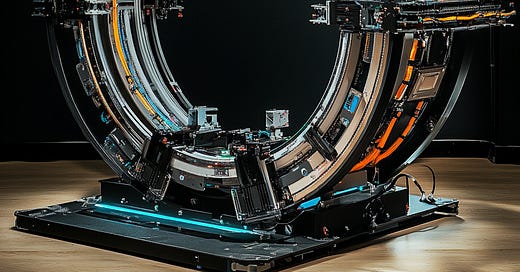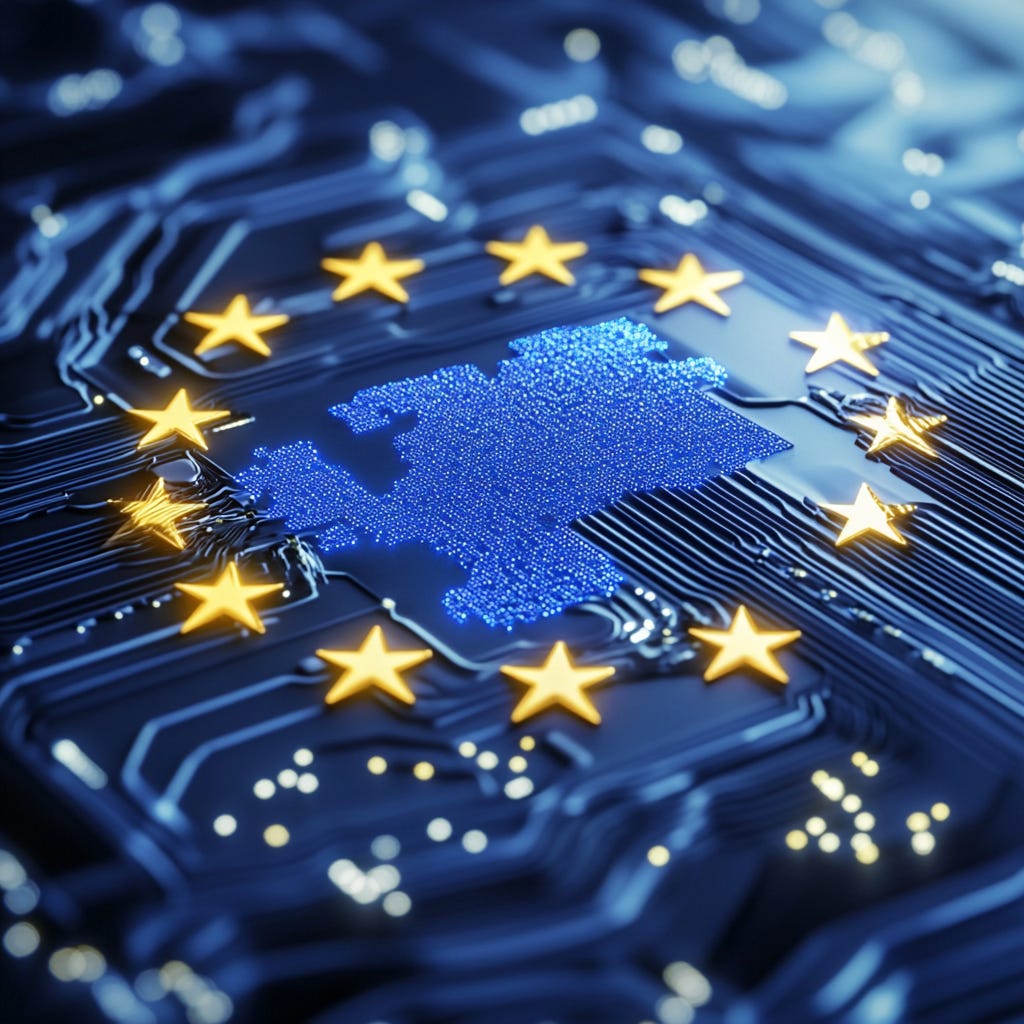Everyone's got robotics all wrong.
The conventional narrative is tediously predictable: America leads in AI, China dominates manufacturing, and Europe plays catch-up while drowning in regulation.
It's a comfortable story that completely misses what's actually happening on the ground.
Most enterprises treat sustainability like an afterthought—a checkbox to tick, a report to file, a marketing slogan to deploy. Meanwhile, Europe has already made it foundational to its industrial policy. That difference is about to redefine robotics forever.
After last two decades in high tech, Fortune 500 and dozens of startups , I've learned one fundamental truth that most tech entrepreneurs miss:
Sustainability isn't a barrier to scale—it's your competitive moat in a world where resources are finite and accountability is inevitable.
This isn't the AI that generates pretty pictures or writes mediocre blog posts. This is the AI that will actually transform physical reality through the next generation of advanced robotics systems.
And Europe is crushing it.
The AI That Actually Matters for Robotics
Let's get something straight: ChatGPT isn't going to build your next factory robot.
The AI that matters for advanced robotics bears little resemblance to the consumer-facing generative AI systems that dominate headlines.
Robotics requires AI systems with fundamentally different capabilities:
1. Multi-modal perception
Advanced robots must process and integrate data from dozens of different sensor types simultaneously—vision systems, force sensors, acoustic inputs, environmental conditions—and create a unified world model in real-time. This requires AI architectures optimized for sensor fusion rather than text processing.
2. Real-time decision making under physical constraints
Robotics AI must make decisions in milliseconds while respecting physical laws and safety parameters. There's no "let me think about this for a while" in robotics AI—it's immediate action or failure.
3. Adaptive learning in unpredictable environments
The most valuable robots operate in dynamic, unpredictable environments. Their AI systems must continuously adapt to changing conditions while maintaining safety and performance parameters.
Here's where Europe's advantage becomes clear: while America and China chase large language models and consumer AI applications, European research institutions and companies have maintained a laser focus on exactly these robotics-relevant AI capabilities.
The Hidden Data Advantage Nobody's Talking About
Here's where things get truly interesting—and why I'm betting big on European robotics AI.
Europe possesses a unique data advantage for training advanced robotics AI systems that neither America nor China can match: industrial process data from the world's most sophisticated manufacturing operations.
This isn't the kind of data that's useful for training chatbots. It's the gold standard for developing AI systems that can control complex physical processes with precision and adaptability:
1. Automotive manufacturing process data
European automotive manufacturers have accumulated decades of sensor data from highly automated production lines, creating unmatched training datasets for robotic control systems.
2. Precision engineering process knowledge
Companies like Siemens have digitized the knowledge of generations of master engineers, creating AI training resources that capture subtle physical insights that can't be derived from first principles.
3. Multi-decade equipment performance histories
European industrial companies maintain the world's most comprehensive datasets on equipment performance across full lifecycle operations, providing invaluable training data for predictive maintenance and optimization systems.
The crucial insight here is that this data can't simply be purchased or replicated—it represents decades of accumulated operational experience that's embedded in European industrial operations.
American tech giants can't buy their way into this advantage, and Chinese manufacturers haven't accumulated the same depth of process knowledge.
What appears to be Europe's greatest weakness in technology development—stringent ESG requirements and regulatory frameworks—is actually its secret strength.
These aren't bureaucratic hurdles; they're sophisticated innovation accelerators disguised as compliance requirements.
Europe's sustainability mandates have created something remarkable: an entire industrial ecosystem that thinks in systems rather than products, in lifecycles rather than launch dates, in resource conservation rather than raw consumption.
This isn't just good for the planet—it's becoming essential for market access globally. As climate regulations tighten worldwide, Europe's robotics manufacturers are already operating in the regulatory environment everyone else will eventually face.
Sustainability as the Operating System
Think of sustainability not as a feature but as the operating system upon which all future robotics must run. Just as software that isn't compatible with iOS or Android becomes irrelevant, robotics systems that aren't designed for sustainability will soon be locked out of major markets.
Europe's approach turns ESG from compliance hassle into strategic advantage:
Make trust your brand.
European robotics firms should set transparent standards that go beyond minimum requirements. When your robot enters a factory, hospital, or farm, its sustainability credentials should be as central to its identity as its technical capabilities.
Position sustainability as premium.
The world doesn't need cheaper robots—it needs better ones. Market AI-powered robots from Europe as the safest, most ethical, and most sustainable options globally, commanding premium prices for superior lifecycle performance.
Transform policy into competitive edge.
Frameworks like the European Green Deal aren't burdens—they're blueprints for products that will meet tomorrow's global standards. Use early compliance as market differentiation.
Implementing the Sustainable Robotics Revolution
This isn't abstract theory. Here's how to make it operational:
Embed lifecycle intelligence.
Integrate AI-driven lifecycle analysis into your robotics from design to disposal. Every robot should know its own environmental impact and continuously optimize to reduce it. This means sensors that monitor energy consumption, AI that adapts operations to minimize resource use, and modular designs that facilitate repairs and upgrades rather than replacement.
Create cross-industry partnerships.
European strengths span multiple sectors—automotive precision, healthcare ethics, agricultural sustainability. Form consortia that bring these strengths together to develop robotics solutions that embody European ESG standards while solving complex problems across industries.
Develop circular robotics systems.
Design for disassembly and material recovery from the start. The first robotics manufacturer to create a fully circular product line—where components are systematically recovered, refurbished, and redeployed—will set the standard everyone else must follow.
Make transparency competitive.
Develop and adopt open standards for measuring and reporting the sustainability impact of robotics systems. Then exceed those standards dramatically, making competitors' silence on these metrics a competitive disadvantage.
Real-World Success Stories Emerging
This approach is already yielding results:
Swedish robotics firm ABB has pioneered energy-efficient industrial robots that reduce power consumption by up to 30% while extending component lifespan, creating dual environmental and economic benefits.
German startups like Magazino are developing warehouse robots with modular designs specifically engineered for component reuse and upgrades, extending useful life from 3-5 years to 10+ years.
The Danish-led RELiABLE project is creating self-diagnosing robots that can predict component failure and schedule maintenance before catastrophic failures, reducing waste and downtime simultaneously.
Where Europe Must Double Down to Win
Despite these advantages, Europe faces real challenges in capitalizing on its AI strengths in the robotics domain.
Three specific actions would transform its current advantage into unassailable leadership:
1. Create a Unified European Robotics Data Trust
By establishing protocols for securely sharing industrial process data across companies and countries, Europe could create a training resource for robotics AI that would be impossible for competitors to match. This would require overcoming traditional competitive boundaries, but the strategic advantage would be enormous.
2. Establish Dedicated AI-to-Robotics Transfer Centers
Europe should create specialized institutions focused exclusively on translating AI research into robotics applications. These centers would bridge the gap between academic AI research and commercial robotics development, accelerating the deployment of advanced capabilities.
3. Develop Robotics-Specific AI Compute Infrastructure
The computational requirements for training robotics AI differ significantly from those needed for generative AI. Europe should invest in specialized compute infrastructure optimized for the simulation-heavy workloads required to develop sophisticated control systems.
These actions would leverage Europe's existing advantages while addressing the specific areas where American and Chinese competitors currently maintain edges in general AI development.
The Strategic Implications
The robotics AI race isn't just about economic competition—it has profound implications for global technology leadership and autonomy.
As robotics systems become increasingly central to manufacturing, logistics, healthcare, and other critical sectors, control over the underlying AI becomes a matter of strategic sovereignty.
Europe's unique position at the intersection of industrial expertise and AI development creates an opportunity to establish leadership in ways that align with its broader strategic objectives.
This isn't just about building better robots.
It's about defining the relationship between technology and society for the coming decades.
The robotics systems that emerge from Europe's AI ecosystem will embody different values and priorities than those developed in America or China.
They will prioritize human augmentation over replacement, sustainable operations over maximum extraction, and transparent decision-making over black-box optimization.
The Next 24 Months Will Determine the Future
We're entering a decisive period for global leadership in robotics AI.
The foundational technologies are maturing, application domains are crystallizing, and investment capital is moving toward the most promising approaches.
Europe's challenge now is to recognize its unique advantages and double down on the specific capabilities that matter most for advanced robotics.
This requires moving beyond the prevailing narrative about "catching up" in general AI and instead focusing on the specific AI capabilities where Europe already leads.
The continent's industrial base, combined with its research strengths in robotics-relevant AI domains, creates a foundation for leadership that neither America nor China can easily replicate.
By focusing its resources on this unique intersection, Europe can establish a position in advanced robotics that will shape global technology development for decades to come.
The question isn't whether Europe can compete in the global AI race.
The question is whether Europe will recognize that it's already winning the race that matters most for the future of robotics.





